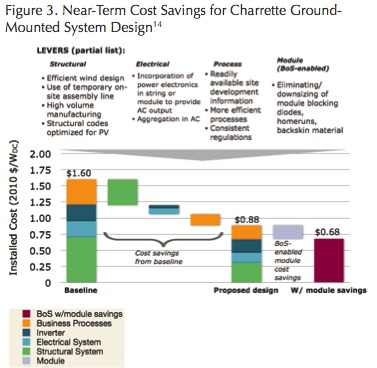 Cutting non-module solar photovoltaic (PV) costs with best design practices could make solar PV cost less than grid electricity for more than 25 percent of Americans.
Cutting non-module solar photovoltaic (PV) costs with best design practices could make solar PV cost less than grid electricity for more than 25 percent of Americans.
Half of the installed cost of a solar PV array is the solar module, but the other half (the “balance of system”) involves labor, assembly, and other components. With module prices continually falling, significant decreases in total installed cost depend on reducing balance of system costs. The Rocky Mountain Institute held a design charette last year, and the result was a concept of how to reduce balance of system costs by 58 percent in five years.
From the report’s executive summary [PDF], this chart (right) illustrates the reduced costs.
Even more interesting, the report put those cost savings in the context of the levelized cost of solar electricity. They found that the balance of system savings (and induced reduction in module costs) could lower the price of solar PV electricity from 22 cents per kWh to 8 cents per kWh.
 To put that in context, I recently examined distributed solar’s cost compared to grid electricity prices, concluding that “solar PV at $5 per watt (with solely the federal tax credit) could not match average grid electricity prices in any of the 20 largest metropolitan areas in the United States.”
To put that in context, I recently examined distributed solar’s cost compared to grid electricity prices, concluding that “solar PV at $5 per watt (with solely the federal tax credit) could not match average grid electricity prices in any of the 20 largest metropolitan areas in the United States.”
With the Rocky Mountain Institute’s best design from their charette, that sentence reads: “solar PV (with solely the federal tax credit) beats average grid electricity prices in 13 of the largest 20 metropolitan areas, representing 78 million Americans.” With time-of-use pricing plans, the number rises to 19 of 20 metro areas, representing over 100 million — one-third of Americans.


